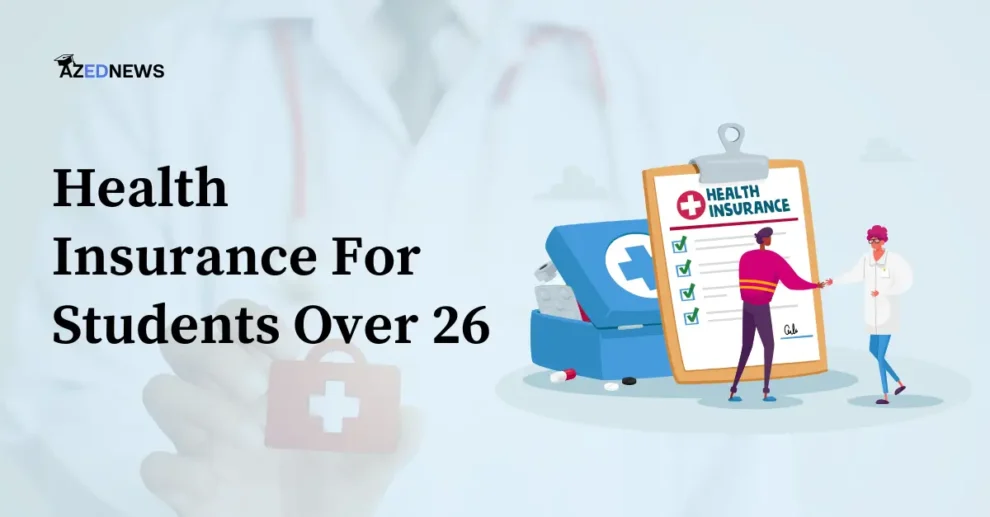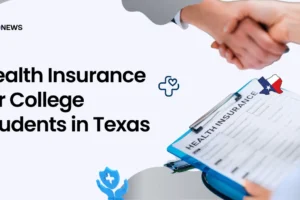Are you looking for health insurance for students over 26? If yes then you are at the right place. When you are going to college, there is more to think about than just classes and fees. Health insurance is an important part of your college journey.
Table of Contents
Luckily, there are different options of health insurance for students over 26, whether you are full-time or part-time, or working while studying. In this article, we will take a closer look at them. Let’s get started.
Key Takeaways
- Check with your school about student health plans, they might be a good fit.
- Catastrophic plans are cheap monthly but have high deductibles. You pay more before insurance kicks in.
- Medicaid is free or low-cost health insurance for people with low income.
- Individual major medical plans cover a lot but can be expensive.
- Short-term plans are good for a short time but do not cover everything.
How To Get Health Insurance For Students Over 26?
Before you choose the best health insurance for college, here is how you can do it:
- First, learn about the different health insurance options available to students.
- Think about what you need from your healthcare coverage. Do you have any health issues that need regular attention?
- Consider how much you can spend on your insurance each month.
- Then, gather quotes from different plans. Compare the costs and what each plan covers.
- Once you have decided, you can apply for coverage online.
- Some plans are easy to get, while others might need more information about your health.
Types of Health Insurance For Students Over 26
Whether you are a parent helping your child or making decisions on your own, there are 5 health insurance options for students. These options are for students over 26 years old. Let’s have a look at them:
1. Student Health Plans
If your school offers health insurance, it is called a student health plan. These plans usually cover important health services, like doctor visits and prescriptions. You can ask your school about it to see if it is a good option for you.
These plans are available to both full-time and part-time students. But it depends on your school’s rules. Some schools have their own criteria for who can get the student health plan.
These plans should cover things like prescription drugs and preventive care at no extra cost. But if your school’s plan is not fully insured, it might have different benefits. Each state has rules for these kinds of plans.
You might want to consider a student health plan if you do not have access to your parents’ insurance, go to school far from home, or if you are over 26 and qualify for the plan at your school.
To find out if your school has a student health plan and if you are eligible, just ask them. They can tell you about the coverage and how to sign up.
2. Catastrophic Health Insurance Plan
If you are over 26 or you have a special reason, like financial hardship, you can think about getting Catastrophic health insurance. These plans usually have low monthly costs but high deductibles. It means you pay more before your insurance starts helping.
With Catastrophic insurance, you will have to pay for most medical bills until you reach your deductible. So, if you get sick or hurt, you might have to pay a lot before your insurance pays anything.
These plans usually cover important health services, like doctor visits and preventive care, without making you pay towards your deductible. You also get a few visits to the doctor each year without paying anything.
This option is good for people over 26, those with a hardship, and students who do not have access to their parents’ insurance. It is also for students who are okay with paying more upfront for their healthcare to have lower monthly costs.
| Policy Duration Limits | 365 Days |
| Year-Round Enrollment | No |
| Guaranteed Issue | Yes |
| ACA Minimum Essential Coverage | Yes |
| Subsidy Eligible | No |
| How Benefits Pay Out | % paid to provider |
To get this insurance, you can sign up on HealthCare.gov or a state exchange. You can only sign up during open enrollment, usually from November to December.
But if something important happens, like you lose other insurance or have a baby, you might be able to sign up at a different time.
3. Medicaid
If you don’t have much money for health insurance, Medicaid could help you out. It gives free or low-cost health coverage to people who don’t earn much.
Both full-time and part-time students can qualify. It is based on how much money you make and other things like where you live.
Medicaid covers things like hospital visits, seeing the doctor, and lab tests. Some states also offer extra benefits like help with prescriptions or therapy sessions. You can check out Medicaid.gov to see what’s available in your state.
It is for students who do not have access to their parents’ health insurance or if it’s too expensive. Even if you are over 26, you might still qualify.
So, if you need help with health costs and you don’t earn much, Medicaid could be a good option for you.
| Policy Duration Limits | 365 Days |
| Year-Round Enrollment | Yes |
| Guaranteed Issue | Yes |
| ACA Minimum Essential Coverage | Yes |
| Subsidy Eligible | No |
| How Benefits Pay Out | % paid to provider |
Getting Medicaid is usually based on how much money you make and where you live. It is for people who need help with health costs but do not earn much.
If you qualify, you can’t be turned down because of your health history or any health issues you had before. This means you can still get Medicaid even if you had medical problems in the past.
Medicaid does not cost much, or sometimes it is free, depending on your situation. Unlike some other health plans, you won’t get tax credits or help with costs from the Affordable Care Act (ACA) if you are on Medicaid.
You can sign up for Medicaid through HealthCare.gov or your state’s health insurance website. Just visit Medicaid.gov to learn more about how it works and if you are eligible.
4. Individual Major Medical Health Insurance Plan Coverage
If your parents or job do not give you health insurance, you might think about getting your own. This type is called individual major medical insurance.
It follows the rules of the Affordable Care Act, which means it covers everything the law says it has to.
This can be a good option if you are a college student and you want health insurance but can’t get it through your parents or job.
If you don’t earn much money, you might even get help paying for it, making it cheaper.
Here is who might think about getting this kind of insurance:
- Students over 26 without a job’s health plan
- Full-time or part-time students
- Students who go to school away from where their parents’ insurance works
- Students who want health insurance that covers everything the law says it should
- Students with health issues from before
- Students who need regular medicine or doctor visits and don’t think other plans will work
- Students who can’t get Medicaid but might qualify for help with paying for insurance
| Policy Duration Limits | 365 Days |
| Year-Round Enrollment | No |
| Guaranteed Issue | Yes |
| ACA Minimum Essential Coverage | Yes |
| Subsidy Eligible | Yes |
| How Benefits Pay Out | % paid to provider |
To get this insurance, you can check out the website HealthCare.gov or your state’s health insurance website. You can also talk to someone who sells health insurance, or look on a website that shows lots of plans.
5. Short Term Health Insurance
If you only need health insurance for a short time, like over the summer or while you are waiting for a job’s insurance to start, short term medical insurance might be a good option for you.
These plans last anywhere from a month to almost a year. It depends on where you live. They are not like regular health insurance though.
They do not cover everything, like check-ups or long-term health problems you already had before getting the insurance. They might not cover you if you have had health issues in the past.
But they are usually cheaper than other plans because they do not cover as much. The less they cover, the less you pay each month.
| Policy Duration Limits | 30 to 365 Days |
| Year-Round Enrollment | Yes |
| Guaranteed Issue | No |
| ACA Minimum Essential Coverage | No |
| Subsidy Eligible | No |
| How Benefits Pay Out | % paid to provider |
So, if you are a college student who needs insurance for a short time, and you cannot get help paying for regular insurance, this could be a good choice.
But it is a good idea to look at different options to see what works best for you. You can find short term insurance online or talk to someone who sells insurance to get started.
Health Insurance For Students Over 26 Summary
| Option | Description | Suitable for |
| Student Health Plan | Offered by college | Full-time/part-time students depending on school rules |
| Catastrophic Plan | Low monthly cost, high deductible | Under 30 or with hardship, okay with high upfront costs |
| Medicaid | Free/low-cost for low income | Low income students |
| Individual Plan | Follows ACA rules | Students who can’t get insurance from parents or job |
| Short-Term Plan | Temporary coverage | Students needing short-term coverage |
Frequently Asked Questions
1. What is the best health insurance for independent college students?
If you are a student and need health insurance, there are some good options out there. Blue Cross Blue Shield is a popular choice for many students. But if you need more specific coverage, companies like UnitedHealthcare, Everest, and Compass are also worth looking into.
2. Do you get free healthcare as a student?
If you are studying for less than six months, you can’t sign up with a doctor permanently, but you can still sign up as a temporary patient. This means you can visit your GP for free, but if you need to see a specialist, you might have to pay for it. So, even if you are not staying long, you can still get medical help when you need it.
3. Can an international student get health insurance in the USA?
If you are studying in the USA and you are from another country, you must get international student insurance. You cannot even sign up for classes without it. Healthcare is not free for international students, so you will have to find a way to pay for it.
4. How much is the cheapest health insurance in the US?
If you are searching for affordable health insurance, you can look into Kaiser Permanente, Aetna, or Ambetter. They offer Bronze plans, which are usually the cheapest and still give you good medical benefits. On average, a Bronze plan costs about $462 per month in 2024. These plans follow the rules of the Affordable Care Act (ACA).
Conclusion
In the United States, there are many options for health insurance for students over 26. Every health insurance plan comes with its costs and perks.
So it is very important to choose the one that fits your needs. You must carefully analyze all the options that are available and then choose the health insurance plan that works the best for you.






















Add Comment